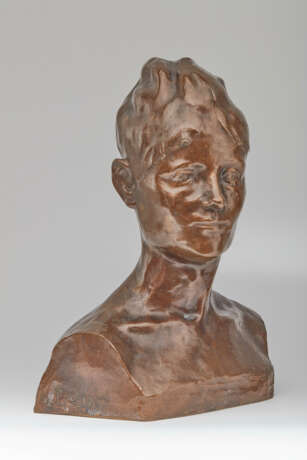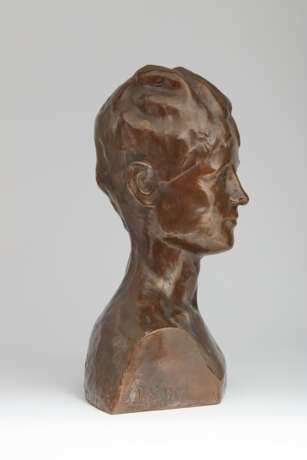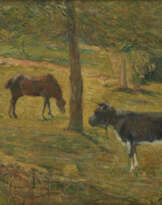ID 1051712
Lot 414 | d'après Paul Gauguin (1848-1903)
Estimate value
€ 3 500 – 4 500
Buste de Madame Schuffenecker
signé des initiales et numéroté ‘5⁄10 PGO’ (sur la gauche); avec le cachet du fondeur ‘CIRE PERDUE C. VALSUANI’ (à l’arrière)
bronze à patine brune
Hauteur: 43.8 cm.
Conçu vers 1890; cette épreuve fondue vers 1960-61 dans une édition de 10 exemplaires
signed with the initials and numbered '5⁄10 PGO' (on the left); stamped with the foundry mark 'CIRE PERDUE C. VALSUANI' (at the back)
bronze with brown patina
Height: 17 ¼ in.
Conceived circa 1890; this bronze cast circa 1960-61 in an edition of 10
Provenance
Maurice Malingue, Paris (vers 1960).
Sam Josefowitz, Pully (acquis auprès de celui-ci le 16 octobre 1961).
Puis par descendance aux propriétaires actuels.
Literature
‘Objets signés, objets surpayés’, in Connaissance des Arts, Paris, 22 avril 1962, p. 79 (illustré).
C. Gray, Sculpture and Ceramics of Paul Gauguin, Baltimore, 1963, p. 210, no. 89 (la version en plâtre illustrée).
Exhibited
Vienne, Galerie du Belvédère, Paul Gauguin, juin-juillet 1960, p. 49, no. 133.
Further details
Si en premier lieu Claude-Émile Schuffenecker voue une admiration très forte à Paul Gauguin – qui le surnomme en retour "le bon vieux Schuf" – ce respect mutuel se délite à la fin des années 1880. Wayne Anderson publie en effet un texte, Gauguin, Paradise lost (New York, 1971), dans lequel il dévoile la relation intime qui unit Gauguin et Madame Schuffenecker. À cette époque, l’admiration de Schuffenecker pour le maître est telle qu’il accepte simplement cette relation adultère. La faiblesse du mari est immortalisée par Gauguin dans son œuvre de 1889, L’Atelier de Schuffenecker ou La famille Schuffenecker, où Claude-Èmile est représenté comme un homme chétif et hésitant, se cachant presque derrière son chevalet, par opposition à son épouse, qui domine majestueusement la composition. Le présent bronze, conçu trois ans avant cette indiscrétion, nous présente Madame Schuffenecker de manière calme et apaisée, ce qui contraste avec l’ultime œuvre de Gauguin représentant sa maîtresse. Le vase en céramique, que l’artiste conçoit en 1889, portraiture en effet Madame Schuffenecker mordue par un serpent enroulé autour de sa tête et symbolisant sans doute l’emprise qu’elle a pu avoir sur lui.
At first Claude-Èmile Schuffenecker idolized Paul Gauguin as the fautless master. In turn, Gauguin’s nickname for Schuffenecker was "good old Schuf". Nevertheless, towards the end of the 1880s the relationship took an unpleasant turn, as Wayne Anderson discusses in his text ‘Gauguin, Paradise lost’ (New York, 1971), recounting Gauguin’s open affair with Madame Schuffenecker. Such was the extent of Schuffenecker’s awe for his colleague that at first he simply put up with the relationship. The final strike came with the completion of Gauguin’s group portrait L’Atelier de Schuffenecker ou La famille Schuffenecker from 1889, where Claude-Èmile was portrayed as a weak figure, crouching behind his easel whilst Madame resplendently dominates the scene. The present bronze, executed some three years earlier, shows Madame Schuffenecker in a more demure pose. The final chapter in Gauguin’s relationship with Madame Schuffenecker was incarnated by a ceramic vase he made also in 1889: he portrays Madame being bitten by a snake, coiled around her head, possibly symbolising what was for Gauguin a toxic relationship.
| Artist: | Paul Gauguin (1848 - 1903) |
|---|---|
| Applied technique: | Metalwork |
| Medium: | Bronze |
| Artist: | Paul Gauguin (1848 - 1903) |
|---|---|
| Applied technique: | Metalwork |
| Medium: | Bronze |
| Address of auction |
CHRISTIE'S 9 Avenue Matignon 75008 Paris France | ||||||||||||||
|---|---|---|---|---|---|---|---|---|---|---|---|---|---|---|---|
| Preview |
| ||||||||||||||
| Phone | +33 (0)1 40 76 85 85 | ||||||||||||||
| Fax | +33 (0)1 40 76 85 86 | ||||||||||||||
| Conditions of purchase | Conditions of purchase | ||||||||||||||
| Shipping |
Postal service Courier service pickup by yourself | ||||||||||||||
| Payment methods |
Wire Transfer | ||||||||||||||
| Business hours | Business hours
|









![[JARRY, Alfred (1873-1907) et Remy de GOURMONT (1858-1915), éd.]](/assets/image/picture_3807179/db0f3/9f8a9c9f9f96b44499182a8f6613e35b1710234000jpg__fix_162_205.jpeg)
![[REVUES]](/assets/image/picture_3807250/6bf13/dc3db82894376503e72508d2fd423b8b1710234000jpg__fix_162_205.jpeg)







